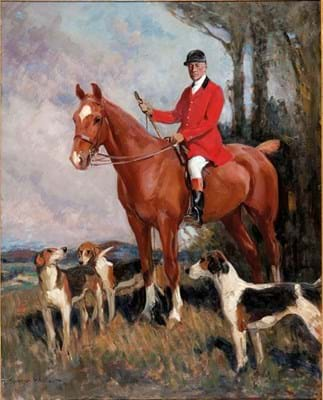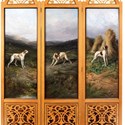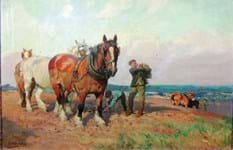Hunting, shooting, fishing and other traditional outdoor pursuits flourished in Victorian Britain, but with the dawn of modern sports, their popularity dived.
With the opening last year of a new national gallery dedicated to traditional sporting art at Palace House in Newmarket, Byatt-Smith hopes it will put such pursuits “back into people’s minds” and push more collectors towards the genre.
Sporting pictures have struggled since the more bouyant years of 30 years ago when collectors drove demand, typically paying around three times more for a painting than they would today. But the current market represents good value for money, says Byatt-Smith.
“Yes, the collecting market has softened. Not at the upper end, such as for Stubbs and Munnings, but certainly at this level there has been a change from people buying to collect, to buying to decorate,” he says.
Dedicated auctions
Since Bonhams’ Dogs in Show and Field auctions wrapped up in New York last year, the Sporting Sales in Edinburgh are now the only dedicated formats of their type held by the auction house.
These auctions include collectables relating to the traditional field sports, but the main focus is on sporting pictures, especially the middle market (works valued at around £10,000 to over £200,000) and the lower end.
Horses, dogs and general hunting scenes are the most popular subjects at these sales and they still appeal to home furnishers looking for traditional décor. The sales are almost exclusively private – from consignments to buyers – with only minimal interest from the trade.
“Condition more than anything is what counts these days,” adds Byatt-Smith. “Our clients want pictures that will go straight on the wall. But good names also help.”
The latest sale held on May 23 ran to 234 lots, dispersed with a respectable 78% and totalled £215,645 to a variety of private buyers based mainly in the UK and the US.
More to collectors’ tastes, rather than home furnishers’, was the auction top lot: a set of three 4ft 6in x 20in (1.37m x 51cm) oil on canvas images of champion pointers by George Earl (1824-1908).
An early survivor of pointing dog history, it depicts Hamlet (painted in 1868), Bang (1876) and Drake (1875), set into a screen designed by modern furniture-maker David Linley.
These were painted in the years following the first field dog trial in 1865, which marked a turning point in the breeding of the pointer. Both Hamlet and Drake were described as the leading dogs in the earliest years of these trials, which involved the finest gun dogs pitted against each other, with judgment passed by an authoritative body. Bang enjoyed similar success and would sire the majority of future winners in the first decades of the trials.
Consigned from private collection, the screen sold to a private buyer on bottom estimate at £20,000.
Incidentally, demand for mementoes from early dog trials was also witnessed earlier in May at Dublin auction house Whyte’s. It sold a show dog collar belonging to the champion Irish red setter Garryown, who dominated his field in the 1870s and ‘80s, for over six times its guide at €6600 (about £5100).
Decorator market
Primed for the decorator market at Bonhams was a pair of Frederic Whiting (1874-1962) portraits in gilt frames. Bid to £9000, against an £5000-7000 guide, was the catalogue cover lot, a 4ft 2in x 3ft 3in (1.26 x 1m) oil on canvas of Robert Henry Harries. Harries was the master of foxhounds between 1902-14 for the Carmarthenshire Hunt and the painting was presented to him on his retirement.
The other picture, a near identical-size portrait of his wife, Arabella Harries, mounted on a horse, sold for £8000 against the same guide.
American interest centred on a typical canine picture by William Woodhouse (1857-1939). Dogs and game, a signed 11 x 15in (29 x 39cm) oil on canvas, was pursued to £5500 against a £2000-3000 estimate.



















